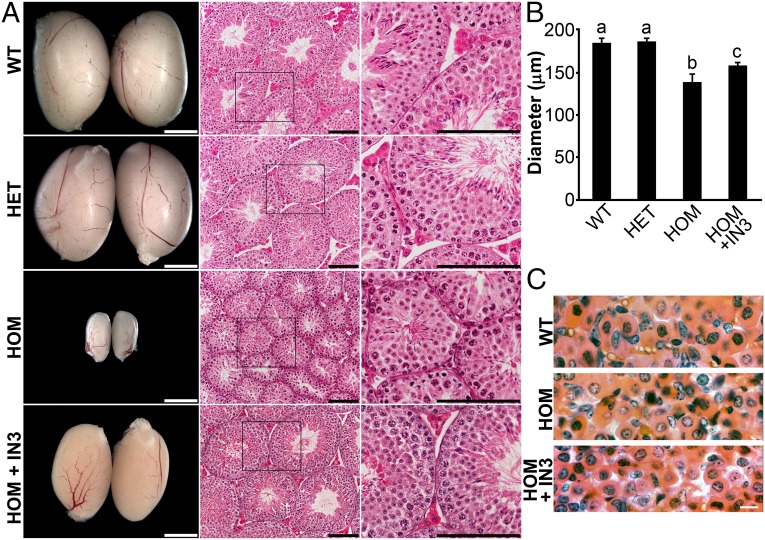Fig. 3.
(A) Male phenotype. Testes from the indicated genotypes were collected at 90 d of age, imaged with a stereomicroscope, and histology was examined by H&E staining. WT and E90Kneo/+ (HET) testes were indistinguishable in size, appearance, abundance of Leydig cells, and presence of spermatozoa in the seminiferous tubules. The testes of E90Kneo/E90Kneo (HOM) males were smaller and exhibited varying degrees of hypogonadism. There were few to no eosin-stained Leydig cells or elongated spermatids. Treatment of E90Kneo/E90Kneo males with pharmacoperone IN3 for 30 d (HOM + IN3) resulted in increased testis size and restored spermatogenesis. The stereomicroscopic image is shown in Left, and the H&E-stained sections are shown on Center and Right. (B) Spermatogenic activity was assayed by measuring seminiferous tubule diameter (SI Materials and Methods and Table S1). Mean seminiferous tubule diameter was not different between WT and E90Kneo heterozygotes. Seminiferous tubule diameter was reduced in E90Kneo/E90Kneo males. IN3 treatment increased the mean seminiferous tubule diameter of E90Kneo/E90Kneo males, but did not restore it to WT levels. Significant differences (P < 0.05) are denoted by the lowercase letters above each bar. Equivalent means have the same letter; different letters indicate statistically significant differences (a, b, c). Error bars show SEM. For WT, E90Kneo/+, E90Kneo/E90Kneo, and IN3 groups, n = 6, 12, 10, and 12, respectively. (C) Pituitary morphology. Images of the anterior pituitary from WT, E90Kneo/E90Kneo, and IN3-rescued E90Kneo/E90Kneo males look similar. (Scale bars: A Left, 2 mm; A Center and Right, 0.1 mm; C, 10 μm.)

